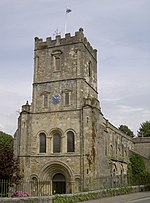Old Wye Bridge, Chepstow

The Old Wye Bridge or Town Bridge at Chepstow, also known historically as Chepstow Bridge, crosses the River Wye between Monmouthshire in Wales and Gloucestershire in England, close to Chepstow Castle. Although there had been earlier wooden bridges on the site since Norman times, the current road bridge was constructed of cast iron in 1816 during the Regency period, by John Rastrick of Bridgnorth, who greatly modified earlier plans by John Rennie. The bridge crosses a river with one of the highest tidal ranges in the world. It carried the main A48 road between Newport and Gloucester until 1988, when a new road bridge was opened downstream alongside Chepstow Railway Bridge. The road bridge now carries local traffic between Chepstow and Tutshill. It is a Grade I listed building.
Excerpt from the Wikipedia article Old Wye Bridge, Chepstow (License: CC BY-SA 3.0, Authors, Images).Old Wye Bridge, Chepstow
Old Wye Bridge,
Geographical coordinates (GPS) Address External links Nearby Places Show on map
Geographical coordinates (GPS)
| Latitude | Longitude |
|---|---|
| N 51.646306 ° | E -2.671944 ° |
Address
Old Wye Bridge
Old Wye Bridge
NP16 7PR , Chepstow
Wales, United Kingdom
Open on Google Maps










